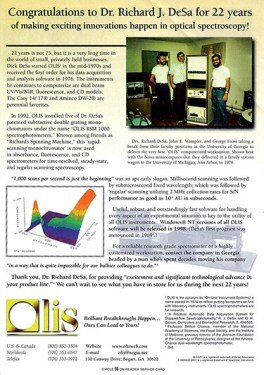10 Simple Techniques For Spectrophotometers
10 Simple Techniques For Spectrophotometers
Blog Article
Everything about Uv/vis
Table of ContentsThe 25-Second Trick For Circular DichroismThe Greatest Guide To Uv/vis/nirUv/vis Can Be Fun For EveryoneWhat Does Uv/vis Do?Spectrophotometers Things To Know Before You Buy

Spectrophotometry is a tool that hinges on the quantitative analysis of particles depending on how much light is taken in by colored substances.
Top Guidelines Of Circular Dichroism
A spectrophotometer is frequently used for the measurement of transmittance or reflectance of solutions, transparent or nontransparent solids, such as refined glass, or gases. Lots of biochemicals are colored, as in, they absorb noticeable light and for that reason can be determined by colorimetric procedures, even colorless biochemicals can typically be converted to colored compounds ideal for chromogenic color-forming reactions to yield compounds suitable for colorimetric analysis.: 65 Nevertheless, they can also be created to measure the diffusivity on any of the noted light varieties that normally cover around 2002500 nm utilizing different controls and calibrations.
An example of an experiment in which spectrophotometry is used is the determination of the equilibrium constant of a service. A specific chemical response within a service might happen in a forward and reverse instructions, where reactants form items and products break down into reactants. At some time, this chemical response will reach a point of balance called an equilibrium point.
Not known Details About Spectrophotometers
The quantity of light that passes through the service is indicative of the concentration of certain chemicals that do not permit light to pass through. The absorption of light is due to the interaction of light with the electronic and vibrational modes of molecules. Each type of molecule has an individual set of energy levels related to the makeup of its chemical bonds and nuclei and hence will take in light of particular wavelengths, or energies, leading to special spectral residential or commercial properties.
They are widely used in many industries consisting of semiconductors, laser and optical production, printing and forensic assessment, as well as in labs for the study of chemical substances. Spectrophotometry is frequently used in measurements of enzyme activities, decisions of protein concentrations, determinations of enzymatic kinetic constants, and measurements of ligand binding reactions.: 65 Eventually, a spectrophotometer is able to determine, depending on the control or calibration, what substances are present in a target and precisely how much through computations of observed wavelengths.
This would come as a solution to the previously produced spectrophotometers which were not able to soak up the ultraviolet properly.
Things about Uv/vis
It would be found that this did not give acceptable results, therefore in Design B, there was a shift from a glass to a quartz prism which permitted better absorbance outcomes - spectrophotometers (https://www.indiegogo.com/individuals/36812837). From there, Model C was born with a modification to the wavelength resolution which wound up having 3 systems of it produced
It irradiates the sample with polychromatic light which the sample takes in depending upon its residential or commercial properties. It is transmitted back by grating the photodiode range which go to website discovers the wavelength area of the spectrum. Ever since, the development and implementation of spectrophotometry gadgets has increased exceptionally and has actually turned into one of the most innovative instruments of our time.

Rumored Buzz on Spectrophotometers
The grating can either be movable or repaired.
In such systems, the grating is fixed and the strength of each wavelength of light is determined by a different detector in the selection. Additionally, most modern mid-infrared spectrophotometers use a Fourier transform method to get the spectral details - http://go.bubbl.us/df2308/dba3?/New-Mind-Map. This technique is called Fourier change infrared spectroscopy. When making transmission measurements, the spectrophotometer quantitatively compares the portion of light that passes through a reference service and a test service, then electronically compares the intensities of the 2 signals and calculates the percentage of transmission of the sample compared to the reference standard.

Report this page